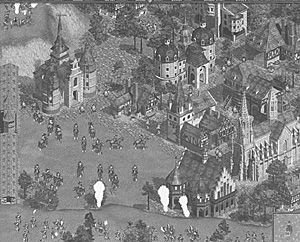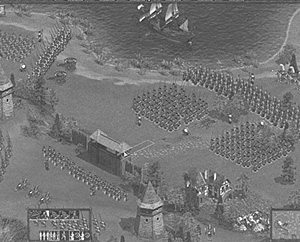 From time to time, a computer game deals with a wargaming subject that is out of the ordinary. "Anno 1602" was one such, although, in the experience of those we have spoken to, it proved rather more a resource management game where any real forays on to the battlefield left one's homeland devastated by political unrest and famine. A new offering by CDV Software Entertainment AG called "Cossacks" addresses these. The "Cossacks" name derives more from the origins of its designers than its subject matter and, unusually, its historical slot is the 16th to mid-18th centuries: Renaissance to Seven Years War. We were lucky enough to get a pre-release beta copy to review and here is your editor's assessment.
From time to time, a computer game deals with a wargaming subject that is out of the ordinary. "Anno 1602" was one such, although, in the experience of those we have spoken to, it proved rather more a resource management game where any real forays on to the battlefield left one's homeland devastated by political unrest and famine. A new offering by CDV Software Entertainment AG called "Cossacks" addresses these. The "Cossacks" name derives more from the origins of its designers than its subject matter and, unusually, its historical slot is the 16th to mid-18th centuries: Renaissance to Seven Years War. We were lucky enough to get a pre-release beta copy to review and here is your editor's assessment.
Not a period much tackled by computer games, the time from the Thirty Tears War to the Age of Reason was one of considerable change for Europe. The colonial aspirations of many European states, religion and dynastic uncertainties in the royal families of several countries all gave an impetus to martial activity. Armies were not huge and the peasantry tended to be left to attend to their largely agricultural pursuits (in major part to feed the armies), so the battles are somewhat more easily managed as part of a computer simulation. Thus, then is the background to "Cossacks".
One is presented with a number of options when starting on play. It is possible to play solo, against a computer opponent or in a multi-player game in a network or internet situation. There are set scenarios, campaign scenarios or specific battles and then there is the start from scratch, build up your nation and armies and see how far you can go option. The company's press release runs as follows:
- January 2001: Four hundred years ago, mainland Europe resounded to the sounds of bloody battles, as nations were created and fell, fortunes made and lost. and new military tactics were developed. It was war on an epic scale and Cossacks": European Wars" is the story of these wars and the men who waged them.
CDV Software Entertainment, fresh from its success with "Sudden Strike", which recreates the battlefields of World War II, has now turned its attention to the colourful chaotic state of European allegiances in the 16th to 18th centuries.
"Cossacks" uses a real-time strategy game engine to pit 16 nations against each other, forming alliances, playing one off against the other, and employing mercenaries to do their dirty work. Each country has its own individual type of fighting units, specific architecture, and economic and military strengths. Britain rules the waves, naturally - so you can choose which state to play according to your own preferences.
When playing "Cossacks", you will need to balance the demands of economic management with military prowess. While resource management at the micro-level is kept to a minimum, you will need to develop your community and acquire new technology °n order to survive in the fast-changing postRenaissance Europe.
Out in the field, territorial expansion will be your primary objective. Each nation has a full complement of land and sea forces and basic weaponry, and the unique 3D contoured terrain means that capturing high points is important and ambushes can be highly
effective. The graphics show units in fine detail and the smooth animation means that the battles are stunning - if not terrifying - to watch as events unfold. "Cossacks" portrays battle on an epic scale - you can play with up to 8,000 units with no loss of game speed.
In single player mode, you can choose to play single missions, a full campaign or tackle the unique challenge thrown up by the random map generator. Mission scenarios are based on real historical battles and campaigns - how you plan your strategy is up to you.
The multi-player game supports up to seven players via a modem, local network or Internet and enables players to recreate actual battles, using realistic maps and authentic troop numbers and formations. In multi-player mode, you can also play a more loosely structured game on the random map.
"Cossacks": European Wars includes representations of over 85 battles from the 16th, 17th and 18th centuries, encompassing the English Civil War, Thirty Years War, and War For Spanish Succession among others. The wealth of historical data incorporated in the game has led the game's developer, the Ukrainian GSC Game World, to include a full encyclopaedia about these turbulent times and military background to the game on the CDROM.
For more information visit www.cossacks.com
 Game Features
Game Features
Up to 8,000 units in a battle with no loss of speed
rival nations
Reconstruction of real historical battles and wars
A huge technological hierarchy of more than 300 inventions and discoveries
Sophisticated military formations available
Huge maps up to 36x36 game screens at 1280x1024 resolution
Special effects - smoke, fog, explosions, buildings burning, explosion rebounds, etc.
Battleships have over 64 frames of movement for ultimate realism
Extensive CD-based encyclopaedia accompanies the game
Up to 7 players in network game
Random map generation
Quick Review
Since I have only had a few days to try the preview copy and, since I'm not sure either that my copy includes all the facilities or how they play (assuming they are all present). However, what I can say is that my experiences so far are pretty well all good. This is how I view "Cossacks":
Graphics: Excellent. The terrain, buildings, people (peasants and troops) are extremely "well drawn" and movement is smooth and realistic. The scrolling (a sort of discovery of surrounding terrain as you move into it) is not in the least jerky and provides a large number of terrain features which affect gameplay.
Sound: Good. The noise of woodmen felling trees, quarrymen breaking rock and the toll of the cathedral (or was it the town hall?) bell all lend realism. Battle noises are present in profusion (at the appropriate times) and there is an accompanying musical library that did not seem out of place. Control over these sounds is available.
Gameplay: This is a strategy game. Lovers of fast-moving shoot-em-ups will not be attracted. If you have played and enjoyed "Anno 1602" and "Settlers II" you will find similarities but "Cossacks" takes you to a new, more playable, less repetitive level. The rather daunting masses of troops and somewhat ponderous game play of such games as "1813" has no part in "Cossacks" which feels far more under the players' control. Whilst there are resource management aspects of the type found in "Anno 1602" and "Settlers II", they do not detract from or prevent the purely military operations. Indeed, they enhance and embellish them. Technical development and training are a must to bring your forces up to a level that will help defeat your enemies. It is still necessary to construct appropriate buildings, to mine resources, to cut wood, to quarry stone and to harvest grain. However, as long as you keep a weather eye on the data at the top of your screen, these can be left to the occasional visit whilst you concentrate on your infantry, cavalry, artillery and ships. Don't be misled, though, if you don't keep your eye on the resources, your troops will be unable to campaign efficiently and might even mutiny.
Having said all that, there are one or two scenarios which do not involve resource management and have a purely military objective.
Player Interface: Generally intuitive. I managed to play several games before
I found the Tutorial campaign and discovered I had only missed out on one or two key features. There are no menus; the mouse and some hot keys do the entire job. Message boxes and control panels appear at the right moments and give you the control you need over what is going on and what you want to do. The designers have done an excellent job here.
A.I.: Difficult one this. I don't think I have given the game enough of a runout to be fair to both player and designer. What I have experienced so far appears to be more than adequate but I must confess I have not had the time to test the A.I.'s abilities to the full. For instance, I have only played at the "Easy" level so far, so what the A.I. does at more difficult levels, I can not say. I hope it doesn't "cheat"! It has surprised me (legitimately) on more than one occasion and beaten me fair and square when I hadn't done a proper job (because I hadn't yet found the Tutorial, I hasten to add) of building an army. However, once I'd corrected my omissions, I generally had the better of the exchanges. On balance, if the design team have done as good a job here as on the graphics, I would be very optimistic.
Gripes: Virtually none. I wish the designers had gone into my favourite Napoleonic period but they didn't set out to do that and I suspect the larger forces involved might have taken things "a bridge too far". I think I would have liked to be able to play a face-to-face game on a single computer but, as far as I can tell, this is not possible - at least in the test version. I would also have preferred a less Russian approach to the scenarios but the design team come from that neck of the woods, so they have wisely dealt with what they know and can thus avoid unnecessary criticism from Western European (and American?) know-it-alls. Finally, I hope they provide a manual with the full market release, or a help feature accessible during game play - both absent in the test copy. For our U.S. readers, I don't think there are any American scenarios or armies but that could well change in the final version or even become the subject of "Cossacks II"???
Summary
Simple. I shall play this one a lot. It is exactly what I want from a strategy wargame dealing with the Pike & Shot/Horse & Musket periods and I'll be amazed if the rest of you don't agree. I think the price should lie somewhere between £ 25 and £ 35 (but that's a guess) and it'll be worth every penny.
Back to Battlefields Issue 10 Table of Contents
Back to Battlefields List of Issues
Back to Master Magazine List
© Copyright 2001 by Partizan Press.
This article appears in MagWeb.com (Magazine Web) on the Internet World Wide Web.
Other articles from military history and related magazines are available at http://www.magweb.com